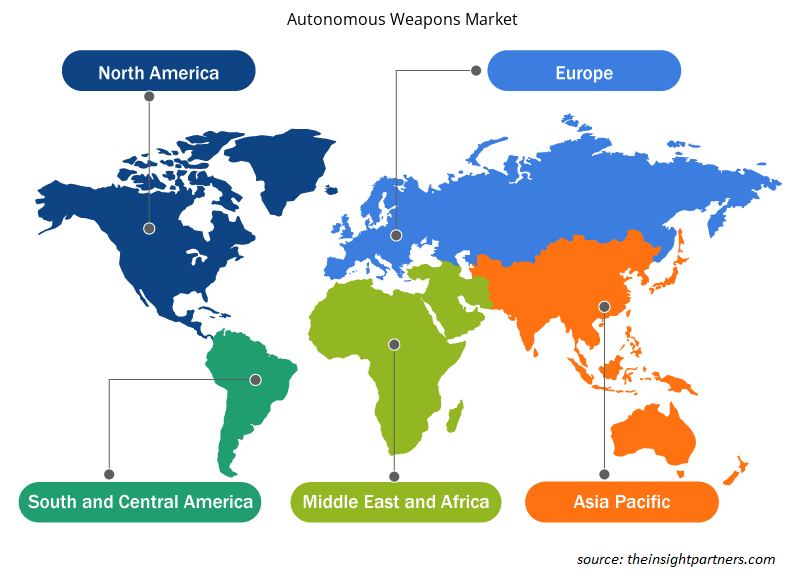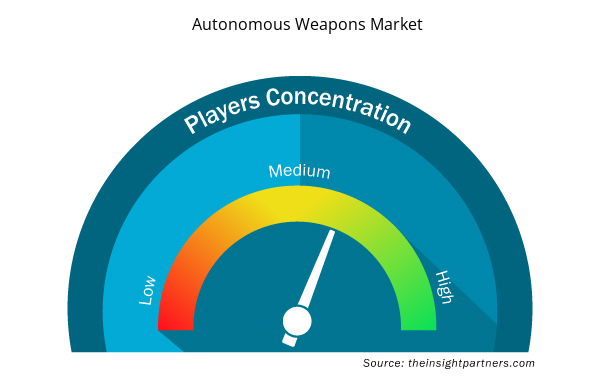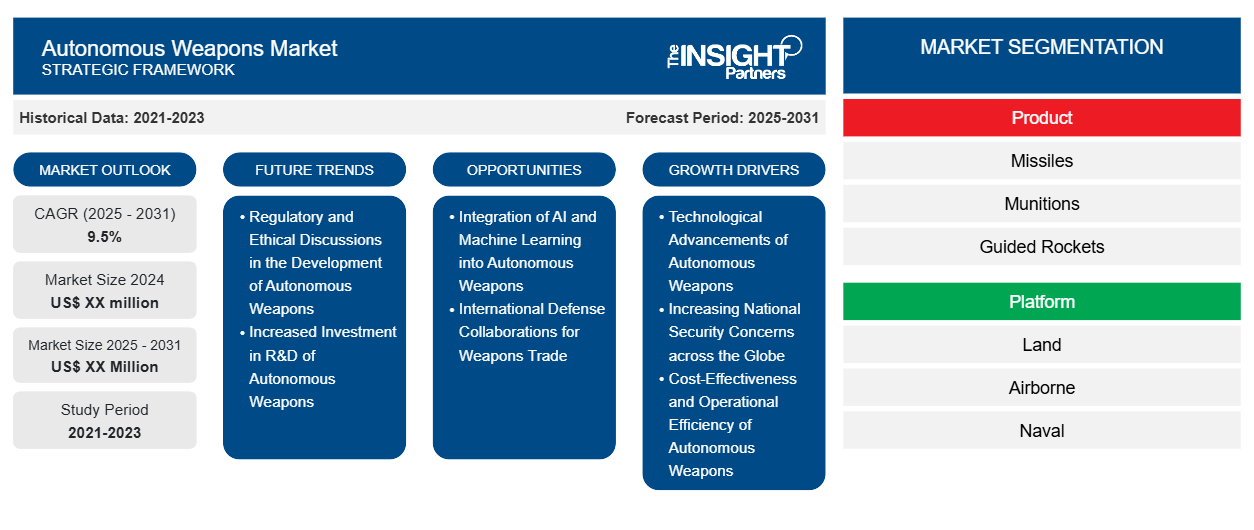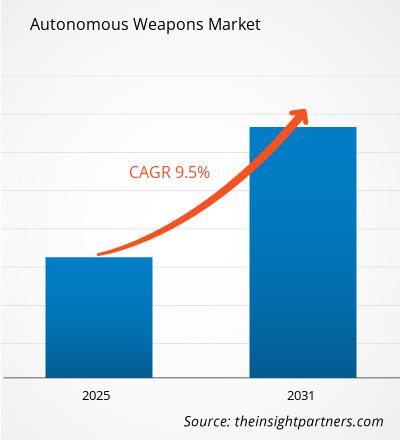Se espera que el mercado de armas autónomas registre una CAGR del 9,5 % entre 2023 y 2031, y que el tamaño del mercado se expanda de XX millones de dólares estadounidenses en 2023 a XX millones de dólares estadounidenses en 2031.
El informe está segmentado por producto (misiles, municiones, cohetes guiados, proyectiles guiados, armas hipersónicas, otros); plataforma (terrestre, aérea, naval); tipo (semiautónomo, autónomo). El análisis global se desglosa aún más a nivel regional y por países principales. El informe ofrece el valor en USD para el análisis y los segmentos anteriores.
Propósito del Informe
El informe Autonomous Weapons Market de The Insight Partners tiene como objetivo describir el panorama actual y el crecimiento futuro, los principales factores impulsores, los desafíos y las oportunidades. Esto proporcionará información a diversas partes interesadas del negocio, como:
- Proveedores/fabricantes de tecnología: Para comprender la dinámica cambiante del mercado y conocer las oportunidades potenciales de crecimiento, lo que les permitirá tomar decisiones estratégicas informadas.
- Inversionistas: Realizar un análisis exhaustivo de tendencias sobre la tasa de crecimiento del mercado, las proyecciones financieras del mercado y las oportunidades que existen en toda la cadena de valor.
- Órganos reguladores: Regular las políticas y vigilar las actividades del mercado con el objetivo de minimizar los abusos, preservar la confianza de los inversores y defender la integridad y la estabilidad del mercado.
Segmentación del mercado de armas autónomas
Producto
- Misiles
- Pertrechos
- Cohetes guiados
- Proyectiles guiados
- Arma hipersónica
- Otros
Plataforma
- Tierra
- Aerotransportado
- Naval
Tipo
- Semiautónomo
- Autónomo
Geografía
- América del norte
- Europa
- Asia-Pacífico
- América del Sur y Central
- Oriente Medio y África
Geografía
- América del norte
- Europa
- Asia-Pacífico
- América del Sur y Central
- Oriente Medio y África
Personalice este informe según sus necesidades
Obtendrá personalización en cualquier informe, sin cargo, incluidas partes de este informe o análisis a nivel de país, paquete de datos de Excel, así como también grandes ofertas y descuentos para empresas emergentes y universidades.
- Obtenga las principales tendencias clave del mercado de este informe.Esta muestra GRATUITA incluirá análisis de datos, desde tendencias del mercado hasta estimaciones y pronósticos.
Factores impulsores del crecimiento del mercado de armas autónomas
- Avances tecnológicos de las armas autónomas: los rápidos avances en inteligencia artificial (IA), aprendizaje automático y robótica son impulsores importantes del mercado de armas autónomas. Estas tecnologías mejoran las capacidades de los sistemas no tripulados, lo que permite una orientación más precisa, una mejor toma de decisiones y tiempos de respuesta reducidos. A medida que las fuerzas militares de todo el mundo invierten en el desarrollo de sistemas de armas avanzados, la integración de la IA permite que las armas autónomas funcionen con mayor eficiencia y eficacia en escenarios de combate. La investigación y el desarrollo en curso en tecnología de sensores y análisis de datos mejoran aún más las capacidades operativas de estos sistemas, lo que impulsa la demanda en el mercado.
- Las crecientes preocupaciones en materia de seguridad nacional en todo el mundo: las crecientes preocupaciones en materia de seguridad nacional y las tensiones geopolíticas están impulsando la demanda de armas autónomas. Los países se centran cada vez más en fortalecer sus capacidades de defensa para disuadir amenazas potenciales y mantener la superioridad militar. La necesidad de armamento avanzado que minimice el riesgo humano y maximice la eficacia operativa impulsa las inversiones en sistemas autónomos. A medida que las naciones buscan abordar los desafíos de la guerra asimétrica y mejorar su posicionamiento estratégico, la adquisición de armas autónomas se convierte en una prioridad, lo que impulsa el crecimiento del mercado en este sector.
- Rentabilidad y eficiencia operativa de las armas autónomas: la búsqueda de soluciones militares rentables es un factor decisivo en el mercado de las armas autónomas. Los sistemas autónomos pueden reducir los costos operativos al minimizar la necesidad de personal humano en entornos de alto riesgo, lo que reduce los gastos de capacitación y logística. Además, estas armas pueden operar en diversas condiciones sin fatiga, lo que genera una eficiencia operativa sostenida durante períodos prolongados. A medida que los presupuestos de defensa se vuelven limitados, las organizaciones militares buscan cada vez más tecnologías que brinden ventajas tácticas al tiempo que optimizan la asignación de recursos. Esta tendencia hacia la rentabilidad contribuye significativamente al crecimiento del mercado de armas autónomas.
Tendencias futuras del mercado de armas autónomas
- Discusiones éticas y regulatorias en el desarrollo de armas autónomas: Una tendencia notable en el mercado de armas autónomas son las discusiones éticas y regulatorias en curso en torno a su desarrollo y uso. A medida que los sistemas autónomos se vuelven más frecuentes en aplicaciones militares, han surgido preocupaciones con respecto a la rendición de cuentas, la toma de decisiones y el cumplimiento de las leyes humanitarias internacionales. Los gobiernos, las ONG y las partes interesadas de la industria están debatiendo activamente las implicaciones del despliegue de armas autónomas. Esta tendencia está generando demandas de regulaciones y pautas claras para regular su uso, lo que influye en el panorama del mercado a medida que las empresas adaptan sus estrategias para alinearse con las consideraciones éticas en evolución y los posibles marcos regulatorios.
- Aumento de la inversión en I+D de armas autónomas: existe una tendencia significativa de aumento de la inversión en investigación y desarrollo (I+D) dentro del mercado de armas autónomas. A medida que las naciones reconocen la importancia estratégica de las tecnologías militares avanzadas, los presupuestos de defensa se asignan cada vez más a iniciativas de I+D centradas en sistemas autónomos. Esta tendencia está impulsada por el deseo de mantener la superioridad tecnológica en un panorama de defensa en rápida evolución. Es probable que las empresas que prioricen la I+D en armas autónomas lideren el mercado mediante el desarrollo de soluciones innovadoras que satisfagan las demandas de la guerra moderna, posicionándose favorablemente para el crecimiento futuro y la ventaja competitiva.
Oportunidades de mercado para las armas autónomas
- Integración de la IA y el aprendizaje automático en las armas autónomas: la integración de la IA y el aprendizaje automático en los sistemas de armas autónomas presenta importantes oportunidades de innovación y expansión del mercado. Al aprovechar los algoritmos de IA, estos sistemas pueden mejorar la identificación de objetivos, mejorar el conocimiento de la situación y aprender de enfrentamientos anteriores para refinar sus estrategias operativas. Las empresas que se centran en el desarrollo de tecnologías de vanguardia impulsadas por IA para armas autónomas pueden captar una parte considerable del mercado. Esta oportunidad es particularmente relevante para los contratistas de defensa y las empresas de tecnología que pueden colaborar para crear soluciones avanzadas que aborden las necesidades cambiantes de la guerra moderna.
- Colaboraciones internacionales en materia de defensa para el comercio de armas: La creciente tendencia de las colaboraciones y asociaciones internacionales en materia de defensa abre nuevas oportunidades en el mercado de las armas autónomas. Los países participan cada vez más en proyectos de desarrollo conjunto y acuerdos de intercambio de tecnología para mejorar sus capacidades de defensa. Estas colaboraciones permiten la puesta en común de recursos, conocimientos y financiación, lo que permite un desarrollo y despliegue más rápidos de sistemas de armas autónomas. Las empresas que puedan aprovechar estas asociaciones y establecerse como actores fiables en empresas conjuntas se beneficiarán de un mayor acceso a los mercados globales, lo que fomentará el crecimiento y la innovación en el sector.
Perspectivas regionales del mercado de armas autónomas
Los analistas de Insight Partners explicaron en detalle las tendencias y los factores regionales que influyen en el mercado de armas autónomas durante el período de pronóstico. Esta sección también analiza los segmentos y la geografía del mercado de armas autónomas en América del Norte, Europa, Asia Pacífico, Oriente Medio y África, y América del Sur y Central.

- Obtenga datos regionales específicos para el mercado de armas autónomas
Alcance del informe sobre el mercado de armas autónomas
| Atributo del informe | Detalles |
|---|---|
| Tamaño del mercado en 2023 | XX millones de dólares estadounidenses |
| Tamaño del mercado en 2031 | US$ XX millones |
| CAGR global (2023 - 2031) | 9,5% |
| Datos históricos | 2021-2022 |
| Período de pronóstico | 2024-2031 |
| Segmentos cubiertos | Por producto
|
| Regiones y países cubiertos | América del norte
|
| Líderes del mercado y perfiles de empresas clave |
|
Densidad de actores del mercado de armas autónomas: comprensión de su impacto en la dinámica empresarial
El mercado de armas autónomas está creciendo rápidamente, impulsado por la creciente demanda de los usuarios finales debido a factores como la evolución de las preferencias de los consumidores, los avances tecnológicos y una mayor conciencia de los beneficios del producto. A medida que aumenta la demanda, las empresas amplían sus ofertas, innovan para satisfacer las necesidades de los consumidores y aprovechan las tendencias emergentes, lo que impulsa aún más el crecimiento del mercado.
La densidad de actores del mercado se refiere a la distribución de las empresas o firmas que operan dentro de un mercado o industria en particular. Indica cuántos competidores (actores del mercado) están presentes en un espacio de mercado determinado en relación con su tamaño o valor total de mercado.
Las principales empresas que operan en el mercado de armas autónomas son:
- Sistemas BAE
- Dinámica Denel
- Sistemas de misión de General Dynamics
- Industrias Aeroespaciales de Israel Ltd.
- Corporación Lockheed Martin
Descargo de responsabilidad : Las empresas enumeradas anteriormente no están clasificadas en ningún orden particular.

- Obtenga una descripción general de los principales actores clave del mercado de armas autónomas
Puntos de venta clave
- Cobertura integral: el informe cubre exhaustivamente el análisis de productos, servicios, tipos y usuarios finales del mercado de armas autónomas, proporcionando un panorama holístico.
- Análisis de expertos: el informe se compila sobre la base de un profundo conocimiento de expertos y analistas de la industria.
- Información actualizada: El informe asegura relevancia comercial debido a su cobertura de información reciente y tendencias de datos.
- Opciones de personalización: este informe se puede personalizar para satisfacer los requisitos específicos del cliente y adaptarse adecuadamente a las estrategias comerciales.
Por lo tanto, el informe de investigación sobre el mercado de armas autónomas puede ayudar a abrir camino para descifrar y comprender el escenario de la industria y las perspectivas de crecimiento. Si bien puede haber algunas preocupaciones válidas, los beneficios generales de este informe tienden a superar las desventajas.
- Análisis histórico (2 años), año base, pronóstico (7 años) con CAGR
- Análisis PEST y FODA
- Tamaño del mercado Valor/volumen: global, regional, nacional
- Industria y panorama competitivo
- Conjunto de datos de Excel



Report Coverage
Revenue forecast, Company Analysis, Industry landscape, Growth factors, and Trends

Segment Covered
This text is related
to segments covered.

Regional Scope
North America, Europe, Asia Pacific, Middle East & Africa, South & Central America

Country Scope
This text is related
to country scope.
Preguntas frecuentes
The report can be delivered in PDF/PPT format; we can also share excel dataset based on the request.
The leading players operating in the Autonomous Weapons Market include BAE Systems plc, Israel Aerospace Industries Ltd., Kongsberg Gruppen ASA, Lockheed Martin Corporation, MBDA, Northrop Grumman Corporation, Rafael Advanced Defense Systems Ltd., RTX Corporation, Rheinmetall AG, Thales Group
Regulatory Developments and Integration with Cyber Warfare is the key future trend of the Autonomous Weapons Market
The major factors driving the Autonomous Weapons Market is Advancement of the Artificial Intelligence and Robotic Technologies and High Defense Spending
The Autonomous Weapons Market is estimated to witness a CAGR of 9.5% from 2023 to 2031
Trends and growth analysis reports related to Aerospace and Defense : READ MORE..
1.BAE Systems
2.Denel Dynamics
3.General Dynamics Mission Systems
4.Israel Aerospace Industries Ltd.
5.Lockheed Martin Corporation
6.MBDA
7.Northrop Grumman Corporation
8.Raytheon Technologies Corporation
9.Rheinmetall AG
10.Thales Group
The Insight Partners performs research in 4 major stages: Data Collection & Secondary Research, Primary Research, Data Analysis and Data Triangulation & Final Review.
- Data Collection and Secondary Research:
As a market research and consulting firm operating from a decade, we have published and advised several client across the globe. First step for any study will start with an assessment of currently available data and insights from existing reports. Further, historical and current market information is collected from Investor Presentations, Annual Reports, SEC Filings, etc., and other information related to company’s performance and market positioning are gathered from Paid Databases (Factiva, Hoovers, and Reuters) and various other publications available in public domain.
Several associations trade associates, technical forums, institutes, societies and organization are accessed to gain technical as well as market related insights through their publications such as research papers, blogs and press releases related to the studies are referred to get cues about the market. Further, white papers, journals, magazines, and other news articles published in last 3 years are scrutinized and analyzed to understand the current market trends.
- Primary Research:
The primarily interview analysis comprise of data obtained from industry participants interview and answers to survey questions gathered by in-house primary team.
For primary research, interviews are conducted with industry experts/CEOs/Marketing Managers/VPs/Subject Matter Experts from both demand and supply side to get a 360-degree view of the market. The primary team conducts several interviews based on the complexity of the markets to understand the various market trends and dynamics which makes research more credible and precise.
A typical research interview fulfils the following functions:
- Provides first-hand information on the market size, market trends, growth trends, competitive landscape, and outlook
- Validates and strengthens in-house secondary research findings
- Develops the analysis team’s expertise and market understanding
Primary research involves email interactions and telephone interviews for each market, category, segment, and sub-segment across geographies. The participants who typically take part in such a process include, but are not limited to:
- Industry participants: VPs, business development managers, market intelligence managers and national sales managers
- Outside experts: Valuation experts, research analysts and key opinion leaders specializing in the electronics and semiconductor industry.
Below is the breakup of our primary respondents by company, designation, and region:

Once we receive the confirmation from primary research sources or primary respondents, we finalize the base year market estimation and forecast the data as per the macroeconomic and microeconomic factors assessed during data collection.
- Data Analysis:
Once data is validated through both secondary as well as primary respondents, we finalize the market estimations by hypothesis formulation and factor analysis at regional and country level.
- Macro-Economic Factor Analysis:
We analyse macroeconomic indicators such the gross domestic product (GDP), increase in the demand for goods and services across industries, technological advancement, regional economic growth, governmental policies, the influence of COVID-19, PEST analysis, and other aspects. This analysis aids in setting benchmarks for various nations/regions and approximating market splits. Additionally, the general trend of the aforementioned components aid in determining the market's development possibilities.
- Country Level Data:
Various factors that are especially aligned to the country are taken into account to determine the market size for a certain area and country, including the presence of vendors, such as headquarters and offices, the country's GDP, demand patterns, and industry growth. To comprehend the market dynamics for the nation, a number of growth variables, inhibitors, application areas, and current market trends are researched. The aforementioned elements aid in determining the country's overall market's growth potential.
- Company Profile:
The “Table of Contents” is formulated by listing and analyzing more than 25 - 30 companies operating in the market ecosystem across geographies. However, we profile only 10 companies as a standard practice in our syndicate reports. These 10 companies comprise leading, emerging, and regional players. Nonetheless, our analysis is not restricted to the 10 listed companies, we also analyze other companies present in the market to develop a holistic view and understand the prevailing trends. The “Company Profiles” section in the report covers key facts, business description, products & services, financial information, SWOT analysis, and key developments. The financial information presented is extracted from the annual reports and official documents of the publicly listed companies. Upon collecting the information for the sections of respective companies, we verify them via various primary sources and then compile the data in respective company profiles. The company level information helps us in deriving the base number as well as in forecasting the market size.
- Developing Base Number:
Aggregation of sales statistics (2020-2022) and macro-economic factor, and other secondary and primary research insights are utilized to arrive at base number and related market shares for 2022. The data gaps are identified in this step and relevant market data is analyzed, collected from paid primary interviews or databases. On finalizing the base year market size, forecasts are developed on the basis of macro-economic, industry and market growth factors and company level analysis.
- Data Triangulation and Final Review:
The market findings and base year market size calculations are validated from supply as well as demand side. Demand side validations are based on macro-economic factor analysis and benchmarks for respective regions and countries. In case of supply side validations, revenues of major companies are estimated (in case not available) based on industry benchmark, approximate number of employees, product portfolio, and primary interviews revenues are gathered. Further revenue from target product/service segment is assessed to avoid overshooting of market statistics. In case of heavy deviations between supply and demand side values, all thes steps are repeated to achieve synchronization.
We follow an iterative model, wherein we share our research findings with Subject Matter Experts (SME’s) and Key Opinion Leaders (KOLs) until consensus view of the market is not formulated – this model negates any drastic deviation in the opinions of experts. Only validated and universally acceptable research findings are quoted in our reports.
We have important check points that we use to validate our research findings – which we call – data triangulation, where we validate the information, we generate from secondary sources with primary interviews and then we re-validate with our internal data bases and Subject matter experts. This comprehensive model enables us to deliver high quality, reliable data in shortest possible time.


 Obtenga una muestra gratuita de este informe
Obtenga una muestra gratuita de este informe